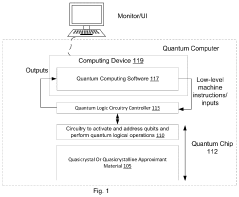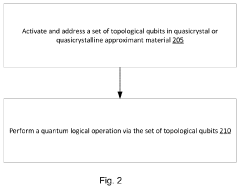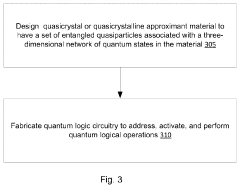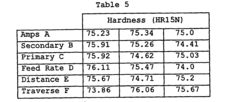Quasicrystal's Role in Future Quantum Computing
Quasicrystal QC Background
Quasicrystals, discovered in 1982 by Dan Shechtman, represent a unique class of materials that exhibit long-range order but lack periodic translational symmetry. This discovery challenged the conventional understanding of crystalline structures and opened up new avenues for research in materials science and physics. In the context of quantum computing, quasicrystals have emerged as a promising candidate for advancing the field due to their distinctive properties.
The fundamental characteristic of quasicrystals that makes them intriguing for quantum computing applications is their aperiodic nature. Unlike traditional crystals with repeating patterns, quasicrystals possess a complex, non-repeating structure that can potentially support unique quantum states. This structural complexity offers the possibility of creating more robust quantum systems that are less susceptible to decoherence, a major challenge in quantum computing.
Quasicrystals exhibit unusual electronic properties, including the presence of localized electronic states and pseudogaps in their electronic band structure. These features could be exploited to create novel quantum bits (qubits) with enhanced stability and coherence times. Additionally, the presence of phasons, collective excitations unique to quasicrystals, may provide new mechanisms for quantum information processing and error correction.
The exploration of quasicrystals in quantum computing is part of a broader trend towards leveraging exotic materials and quantum phenomena to overcome the limitations of classical computing. As traditional silicon-based technologies approach their physical limits, researchers are increasingly turning to alternative materials and architectures to push the boundaries of computational power.
Early theoretical work on quasicrystal-based quantum computing has focused on understanding how the aperiodic structure can be used to create and manipulate quantum states. Some proposed models suggest that quasicrystals could serve as a natural platform for topological quantum computing, a paradigm that promises inherently fault-tolerant quantum operations.
While the potential of quasicrystals in quantum computing is significant, the field is still in its infancy. Experimental realization of quasicrystal-based quantum systems remains a challenge, requiring advanced fabrication techniques and precise control over material properties. Nonetheless, the unique characteristics of quasicrystals continue to inspire researchers to explore their role in shaping the future of quantum computing technologies.
Quantum Computing Market
The quantum computing market is experiencing rapid growth and attracting significant investment as the technology advances towards practical applications. This emerging field holds immense potential to revolutionize various industries, from finance and healthcare to cybersecurity and materials science. The global quantum computing market size was valued at approximately $500 million in 2020 and is projected to reach $65 billion by 2030, growing at a compound annual growth rate (CAGR) of over 60% during the forecast period.
Several factors are driving the expansion of the quantum computing market. Firstly, there is a growing demand for high-performance computing solutions capable of solving complex problems that are beyond the capabilities of classical computers. Industries such as pharmaceuticals, aerospace, and finance are increasingly recognizing the potential of quantum computing to accelerate research and development, optimize processes, and gain competitive advantages.
Government initiatives and investments are also playing a crucial role in market growth. Many countries, including the United States, China, and European nations, have launched national quantum programs and allocated substantial funding to advance quantum technologies. These initiatives aim to establish quantum supremacy and secure technological leadership in this strategic field.
The private sector is equally active in driving quantum computing development. Tech giants like IBM, Google, Microsoft, and Amazon are investing heavily in quantum research and development, while numerous startups are emerging with innovative quantum solutions. This competitive landscape is fostering rapid technological advancements and expanding the range of potential applications.
However, the quantum computing market faces several challenges. The technology is still in its early stages, with many technical hurdles to overcome before achieving widespread commercial viability. Issues such as qubit stability, error correction, and scalability need to be addressed to realize the full potential of quantum systems.
Despite these challenges, the market outlook remains highly promising. As quantum hardware continues to improve and quantum algorithms become more sophisticated, we can expect to see an increasing number of practical applications across various industries. The integration of quantum computing with other emerging technologies like artificial intelligence and blockchain is likely to create new market opportunities and drive further innovation.
In conclusion, the quantum computing market is poised for exponential growth in the coming years. As the technology matures and becomes more accessible, it has the potential to transform industries and solve some of the world's most complex problems. The role of quasicrystals in this evolving landscape could further enhance the capabilities of quantum systems, potentially opening up new avenues for research and application in the quantum computing domain.
Quasicrystal Challenges
Despite the promising potential of quasicrystals in quantum computing, several significant challenges hinder their widespread adoption and practical implementation. One of the primary obstacles is the difficulty in synthesizing high-quality quasicrystals with consistent and predictable properties. The unique aperiodic structure of quasicrystals makes their growth and fabrication processes complex and often unpredictable, leading to variations in their quantum properties.
Another major challenge lies in the precise control and manipulation of quasicrystalline structures at the quantum level. The non-periodic nature of quasicrystals introduces complexities in designing and implementing quantum gates and circuits, which are fundamental components of quantum computers. Researchers are still grappling with developing reliable methods to encode, manipulate, and read quantum information within quasicrystalline systems.
The stability and coherence of quantum states in quasicrystals present another significant hurdle. Quantum systems are inherently sensitive to environmental disturbances, and maintaining quantum coherence for extended periods is crucial for practical quantum computing. The complex structure of quasicrystals may introduce additional sources of decoherence, requiring innovative approaches to protect and preserve quantum information.
Furthermore, the integration of quasicrystals with existing quantum computing architectures poses substantial engineering challenges. Developing interfaces between quasicrystalline quantum systems and conventional quantum hardware, such as superconducting circuits or trapped ions, requires novel design strategies and fabrication techniques. This integration is essential for creating scalable and functional quantum computing systems based on quasicrystals.
Lastly, the theoretical understanding of quasicrystals in the context of quantum computing is still evolving. While their unique properties offer potential advantages, such as enhanced protection against errors and novel quantum states, fully harnessing these benefits requires further advancements in theoretical models and computational simulations. Bridging the gap between theoretical predictions and experimental realizations remains a significant challenge in the field.
Current Quasicrystal QC Tech
01 Quasicrystal structure and composition
Quasicrystals are unique materials with aperiodic atomic structures that exhibit long-range order but lack translational symmetry. They often contain aluminum and transition metals, forming complex alloys with unusual properties. The composition and structure of quasicrystals are crucial for their unique characteristics and potential applications.- Quasicrystal structure and composition: Quasicrystals are unique materials with aperiodic atomic structures that exhibit long-range order but lack translational symmetry. They often contain aluminum and transition metals, forming complex arrangements with unusual symmetries such as five-fold or ten-fold rotational symmetry. These structures can lead to interesting properties like high hardness, low friction, and thermal insulation.
- Manufacturing methods for quasicrystals: Various techniques are employed to produce quasicrystals, including rapid solidification, physical vapor deposition, and mechanical alloying. These methods often involve precise control of composition, temperature, and cooling rates to achieve the desired quasicrystalline structure. Some processes use high-energy ball milling or plasma spraying to create quasicrystalline coatings or bulk materials.
- Applications of quasicrystals: Quasicrystals find applications in various fields due to their unique properties. They are used in non-stick coatings for cookware, wear-resistant and low-friction surfaces in mechanical components, and as reinforcement in composite materials. Quasicrystals also show promise in thermoelectric devices, hydrogen storage materials, and photonic crystals for optical applications.
- Characterization and analysis of quasicrystals: Advanced techniques are used to study and characterize quasicrystals, including high-resolution transmission electron microscopy, X-ray diffraction, and neutron scattering. These methods help in understanding the complex atomic arrangements, phase transitions, and physical properties of quasicrystalline materials. Computational modeling and simulation also play crucial roles in predicting and analyzing quasicrystal structures.
- Novel quasicrystal compositions and alloys: Research continues to explore new compositions and alloys that form quasicrystalline structures. This includes investigating rare earth elements, transition metals, and metalloids to create quasicrystals with enhanced properties or stability. Some studies focus on developing quasicrystalline phases in traditionally non-quasicrystal-forming systems or creating quasicrystal-reinforced metal matrix composites for improved mechanical properties.
02 Manufacturing methods for quasicrystals
Various techniques are employed to produce quasicrystals, including rapid solidification, melt spinning, and vapor deposition. These methods aim to create the specific conditions necessary for quasicrystal formation, often involving precise control of cooling rates and composition. Advanced manufacturing processes can lead to improved quasicrystal quality and yield.Expand Specific Solutions03 Applications of quasicrystals in coatings and surfaces
Quasicrystals find applications in surface coatings due to their unique properties such as low friction, high hardness, and corrosion resistance. They can be used to enhance the performance of various materials and components, particularly in industries requiring wear-resistant and low-friction surfaces.Expand Specific Solutions04 Quasicrystal-based composites and alloys
Incorporating quasicrystals into composites or alloys can lead to materials with enhanced properties. These quasicrystal-reinforced materials often exhibit improved mechanical strength, thermal stability, and wear resistance. Research in this area focuses on optimizing the composition and processing of such composites for various industrial applications.Expand Specific Solutions05 Characterization and analysis of quasicrystals
Advanced characterization techniques are essential for studying the complex structure and properties of quasicrystals. Methods such as electron microscopy, X-ray diffraction, and spectroscopic analyses are employed to investigate the atomic arrangement, composition, and physical properties of quasicrystalline materials. These analyses contribute to a deeper understanding of quasicrystal behavior and potential applications.Expand Specific Solutions
Key Quasicrystal QC Players
The field of quasicrystals in quantum computing is in its early developmental stage, with significant potential for growth. The market size is currently limited but expected to expand as research progresses. Technological maturity varies among key players, with institutions like Massachusetts Institute of Technology, IBM, and Microsoft leading in research and development. Universities such as Nanjing University and the University of Science & Technology of China are making notable contributions. Companies like Origin Quantum Computing Technology and D-Wave Systems are exploring practical applications. The competitive landscape is characterized by a mix of academic institutions, tech giants, and specialized quantum computing firms, each contributing to advancing the understanding and application of quasicrystals in quantum computing.
Massachusetts Institute of Technology
Origin Quantum Computing Technology (Hefei) Co., Ltd.
Quasicrystal QC Innovations
- A quantum computer utilizing quasicrystal or quasicrystalline approximant materials as the basis for qubits, incorporating a quantum topological spin network formalism and entangled spin states, which are designed to have anyonic properties and improved entanglement entropy, enabling fault-tolerant and scalable quantum computing.
- A thermally sprayed coating composed of an Al-Cu-Fe alloy with a specific weight percentage of Cu, Fe, Cr, Co, Ni, Mo, and W, containing at least 50% ψ phase, is developed to achieve high hardness, density, and surface smoothness, utilizing rapid thermal spraying to avoid detrimental δ phase formation and optimize phase equilibria through controlled cooling rates and plasma spraying parameters.
Quantum Materials Research
Quantum materials research has become a cornerstone in the pursuit of advanced quantum computing technologies. The exploration of quasicrystals, a unique class of materials with aperiodic long-range order, has opened new avenues for potential breakthroughs in quantum computing. These materials exhibit exceptional electronic and magnetic properties that could be harnessed to overcome current limitations in quantum bit (qubit) stability and coherence.
Recent studies have shown that certain quasicrystalline structures can host topologically protected quantum states, which are inherently resistant to decoherence. This property is particularly valuable in the development of more robust quantum computing systems. The unique symmetry of quasicrystals also allows for the creation of novel quantum circuit architectures that may offer advantages over traditional crystalline-based designs.
Researchers are investigating the potential of quasicrystalline materials to serve as quantum memory elements. The aperiodic nature of these materials could potentially lead to longer coherence times for stored quantum information, addressing one of the key challenges in quantum computing. Additionally, the exotic electronic states found in quasicrystals may provide new mechanisms for quantum information processing and quantum error correction.
The integration of quasicrystals into quantum computing hardware is still in its early stages, but promising results have been observed in laboratory experiments. For instance, researchers have successfully created quasicrystalline thin films that exhibit quantum coherence at higher temperatures than conventional materials. This could pave the way for quantum computers that operate at more practical temperatures, reducing the need for extreme cooling systems.
Another area of focus is the use of quasicrystals in quantum sensing applications. The unique electronic structure of these materials makes them highly sensitive to external stimuli, potentially enabling the development of ultra-precise quantum sensors. Such sensors could have far-reaching implications for fields beyond computing, including medical imaging and environmental monitoring.
As quantum materials research continues to advance, the role of quasicrystals in future quantum computing systems is likely to expand. Their unconventional properties offer a fresh perspective on tackling longstanding challenges in the field, and may lead to entirely new paradigms in quantum information processing. The ongoing exploration of these materials represents a exciting frontier in the quest for more powerful and reliable quantum technologies.
QC Standardization Efforts
The standardization of quantum computing (QC) technologies is a critical aspect of the field's development, particularly as it relates to the potential integration of quasicrystals. As the quantum computing landscape evolves, there is a growing need for unified standards to ensure interoperability, reliability, and consistency across different platforms and implementations.
Several international organizations and consortia are actively working on establishing QC standards. The IEEE Quantum Computing Standards Working Group is at the forefront of these efforts, focusing on developing standards for quantum computing definitions, performance metrics, and benchmarking methodologies. Their work aims to create a common language and set of measurements for evaluating quantum computing systems, which will be essential as quasicrystal-based quantum technologies emerge.
The International Organization for Standardization (ISO) has also initiated efforts in this domain through its ISO/IEC JTC 1/SC 42 committee on Artificial Intelligence, which includes a working group dedicated to quantum computing. This group is working on standardizing terminology, reference architectures, and quality requirements for quantum computing systems, which may need to be adapted to accommodate quasicrystal-based quantum technologies.
In the United States, the National Institute of Standards and Technology (NIST) is playing a crucial role in QC standardization. NIST's Post-Quantum Cryptography program is particularly relevant, as it aims to develop cryptographic systems that are secure against both quantum and classical computers. As quasicrystals potentially offer new approaches to quantum computing, these standards may need to be revisited to ensure they remain robust against all forms of quantum computation.
The European Telecommunications Standards Institute (ETSI) has established a Industry Specification Group on Quantum Computing (ISG QC), which is working on creating specifications for quantum computing hardware and software. Their efforts include defining interfaces between quantum and classical systems, which will be crucial for integrating quasicrystal-based quantum components with existing classical infrastructure.
As research into quasicrystals' role in quantum computing progresses, it will be essential for these standardization bodies to incorporate new findings and potential applications into their frameworks. This may involve creating new working groups or task forces specifically focused on quasicrystal-based quantum technologies, ensuring that standards evolve in parallel with technological advancements.





